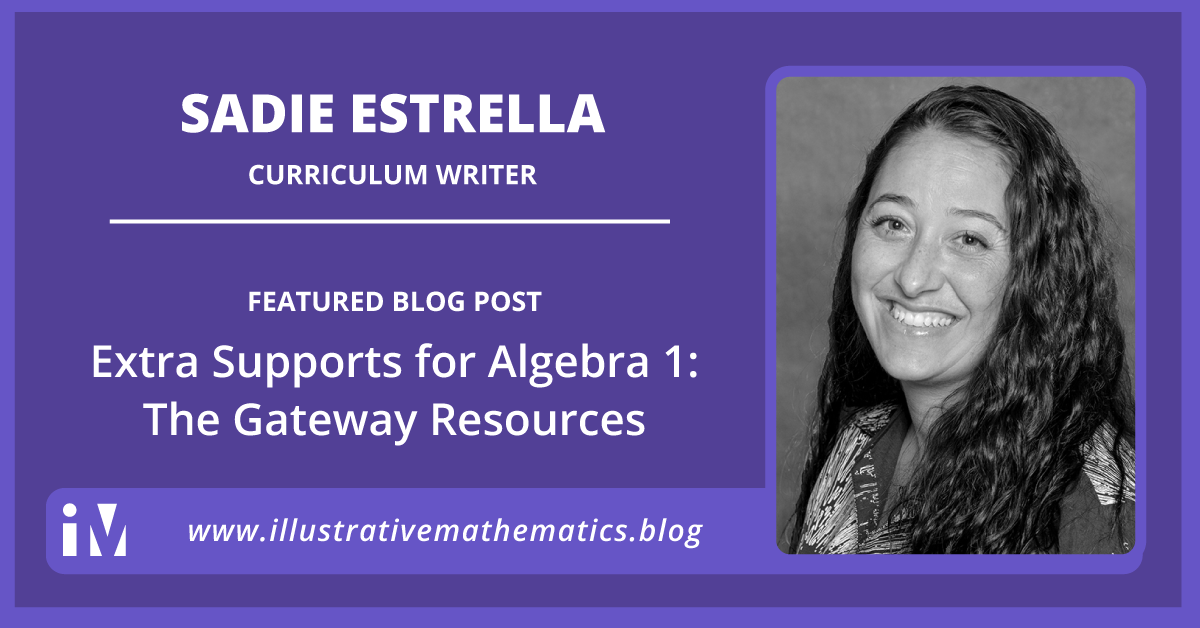By Sadie Estrella
Illustrative Mathematics’ high school curriculum is scheduled to be released this summer. This is an exciting time for Algebra 1, Geometry, and Algebra 2 teachers. I honestly am ready to take a job at a school just to have the opportunity to teach with this material (and everyone knows I am always dreaming of being back in the classroom). However, I want to bring light to a hidden gem I think not too many people are aware of that is also part of our high school materials.
IM is writing an additional set of lessons matched to the lessons in our Algebra 1 course that we are calling Algebra 1 Extra Supports.
Algebra is a gateway to higher-level mathematics. Students who pass Algebra 1 have a greater chance of graduating high school and being successful in the workforce or college. However, there are still many students who are not successful in Algebra 1. Illustrative Mathematics decided to provide supporting materials to help students access Algebra 1 content. Our extra support materials are designed to provide just-in-time learning opportunities, to be taught before their grade-level Algebra 1 lesson. This will allow students to learn or refresh their understanding of the background mathematics they need in order to be successful in their grade-level Algebra 1 course.
There are three common situations where these materials are useful:
- when students have more time for their Algebra 1 work, for example, with a double-blocked schedule
- when students are taking another class, parallel to their Algebra 1 class, to help with unfinished learning from earlier grades
- when students are enrolled in an Algebra 1 course that is spread out over one and a half or two years
In the materials:
- There are numeracy instructional routines written into the daily warm ups.
- There are learning activities after each warm up, followed by a practice activity.
- There are no cool-downs or practice problems.
- There are no assessments.
Instructional Routines
In order to connect to the design in the grade-level Algebra 1 course, specific instructional routines have been identified and used during the extra supports warm-ups. This helps build consistency for students, which in turn creates an environment where students feel safe being vulnerable to learn and engage in doing mathematics.
Structure of a Lesson
The structure of the lessons is:

During the learning activity, students engage in a mathematical task that connects to the prerequisite concepts and skills needed to be successful in the corresponding grade-level Algebra 1 lesson. Students might preview vocabulary or unfamiliar contexts, for example exploring banking and interest prior to a lesson on exponential growth. They might preview a skill from earlier grades, such as finding a percent of a number prior to a lesson on interest rates. Or they might recall a concept from earlier in the year, or from a prior grade-level, such as reviewing what a solution to an equation in one variable means, before a lesson on solutions to systems of equations. The learning activity follows the same structure as all IM curriculum activities: a launch that invites students to the mathematics, an activity with opportunities for group and individual work, and a whole-class activity synthesis that gives students the opportunity to consolidate their learning.
The practice activity gives students time to practice skills or strategies that they learned during a previous learning activity. The practice activity may or may not include an activity synthesis, however, every lesson does include a lesson synthesis to further consolidate the learning and focus on *why* what we practiced might be important in their Algebra 1 class.
Cool-downs, Practice Problems, and Assessments
The purpose of these lessons is to provide support for students who need it to be successful in their grade-level mathematical work. Cool-downs, practice problems, and assessments can be found in students’ grade-level Algebra 1 materials. They are not necessary in the extra supports lessons because the measure of a student’s success in the extra supports lessons is that student’s ability to engage in the aligned Algebra 1 lessons and to be successful on the Algebra 1 assessments.
Call to Action or Next Steps
In all honesty, I am pretty pumped about all the materials we are designing. But the Algebra 1 Extra Supports curriculum holds a very special place in my heart. Students will have greater access to mathematical ideas in Algebra 1 and teachers will have resources to help meet their students’ needs while teaching Algebra 1. So how will this material impact students at your school, district, or classroom? What structures need to be in place for these materials to support students and open their access to Algebra 1?
